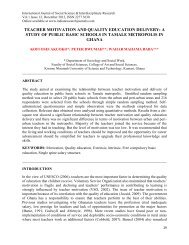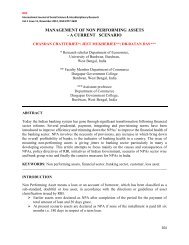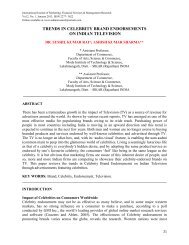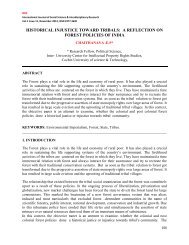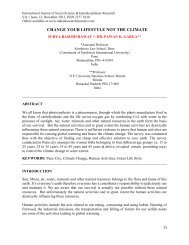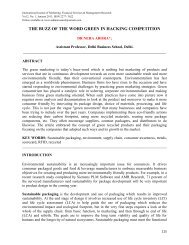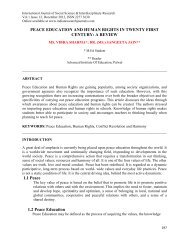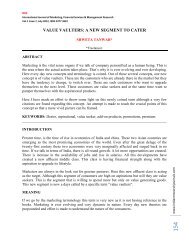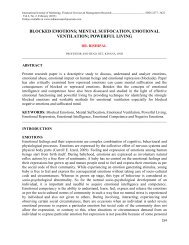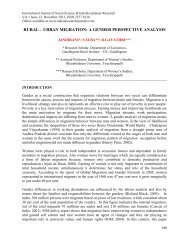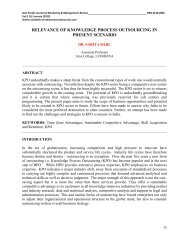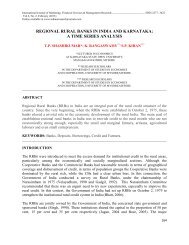application of remote sensing and gis for flood risk analysis: a case ...
application of remote sensing and gis for flood risk analysis: a case ...
application of remote sensing and gis for flood risk analysis: a case ...
Create successful ePaper yourself
Turn your PDF publications into a flip-book with our unique Google optimized e-Paper software.
IRJC<br />
International Journal <strong>of</strong> Social Science & Interdisciplinary Research<br />
Vol.1 Issue 11, November 2012, ISSN 2277 3630<br />
Although the occurrence <strong>of</strong> such disasters cannot be prevented or regulated, the proper<br />
<strong>application</strong> <strong>of</strong> scientific knowledge based on past experience can minimize the economic <strong>and</strong><br />
health consequences <strong>of</strong> the population.<br />
INTRODUCTION:<br />
The natural hazards can be listed as avalanches <strong>and</strong> l<strong>and</strong>slides in Himalayas, cyclones in coastal<br />
areas, drought in rain-scarcity areas, earthquakes in seismic <strong>and</strong> tectonic activities affected areas<br />
<strong>and</strong> <strong>flood</strong>s in heavy rainfall area. Hence effect <strong>of</strong> these hazards causes damages at various<br />
degrees to an extent <strong>of</strong> disaster, the phenomena <strong>of</strong> these kinds <strong>of</strong> disaster due to <strong>flood</strong> dem<strong>and</strong>s a<br />
systematic study.<br />
Disaster means a catastrophe, a calamity or mishap, a grave occurrence, which causes a serious<br />
disruption <strong>of</strong> the functioning <strong>of</strong> a society, causing widespread human, material or environmental<br />
losses exceeding the ability <strong>of</strong> the affected society to cope using only its resources.<br />
A Flood is defined as the overflow <strong>of</strong> areas that are normally submerged with water or a stream<br />
that has broken its normal confines or has accumulated due to lack <strong>of</strong> drainage. Floods are<br />
among the most common <strong>and</strong> destructive natural hazards causing extensive damage to<br />
infrastructure, public <strong>and</strong> private services, the Environment, the economy <strong>and</strong> devastation to<br />
human settlements. The <strong>flood</strong> has different types, they are; River <strong>flood</strong>, Coastal <strong>flood</strong>, urban<br />
<strong>flood</strong>, storm <strong>flood</strong> etc these may be flash <strong>flood</strong> or slow onset <strong>flood</strong>. 28<br />
B. Normal <strong>flood</strong>s are expected <strong>and</strong> generally welcomed in many parts <strong>of</strong> the world as they<br />
provide rich soil, water <strong>and</strong> a means <strong>of</strong> transport, but <strong>flood</strong>ing at an unexpected scale (damaging<br />
<strong>flood</strong>) <strong>and</strong> with excessive frequency causes damage to life, livelihoods <strong>and</strong> the environment.<br />
Over the past decades, the pattern <strong>of</strong> <strong>flood</strong>s across all continents has been changing, becoming<br />
more frequent, intense <strong>and</strong> unpredictable <strong>for</strong> local communities, particularly as issues <strong>of</strong><br />
development <strong>and</strong> poverty have led more people to live in areas vulnerable to <strong>flood</strong>ing. The<br />
Fourth Assessment Report (2007) <strong>of</strong> the Intergovernmental Panel on Climate Change (IPCC)<br />
predicts that „heavy precipitation events, which are very likely to increase in frequency, will<br />
augment <strong>flood</strong> <strong>risk</strong>‟. These <strong>flood</strong>s will affect life <strong>and</strong> livelihoods in human settlements in all<br />
areas, e.g., coastal zones, river deltas <strong>and</strong> mountains. Though there were continuous ef<strong>for</strong>ts to<br />
mitigate <strong>flood</strong> <strong>and</strong> its effects on victims.<br />
C. Floods by nature become a complex event <strong>and</strong> caused a range <strong>of</strong> human vulnerabilities,<br />
inappropriate development planning <strong>and</strong> climate variability with the exception <strong>of</strong> flash <strong>flood</strong>s,<br />
whose scale <strong>and</strong> nature are <strong>of</strong>ten less certain. Hence it requires more comprehensive studies<br />
about <strong>flood</strong> to <strong>for</strong>mulate appropriate strategies to mitigate <strong>flood</strong> <strong>and</strong> its impacts.<br />
NEED FOR THE STUDY<br />
Floods are an endemic problem in India. The National Commission on Floods, more commonly<br />
known by its Hindi name „Rashtriya Barh Aayog‟, in 1980 estimated that about 40 mha <strong>of</strong> area is<br />
<strong>flood</strong>-prone. This was later revised to 33.5 mha. On an average, 7.5 mha Area is affected by<br />
<strong>flood</strong>s in any one year, in some or other part <strong>of</strong> the country. Large <strong>flood</strong> events capture the<br />
52



